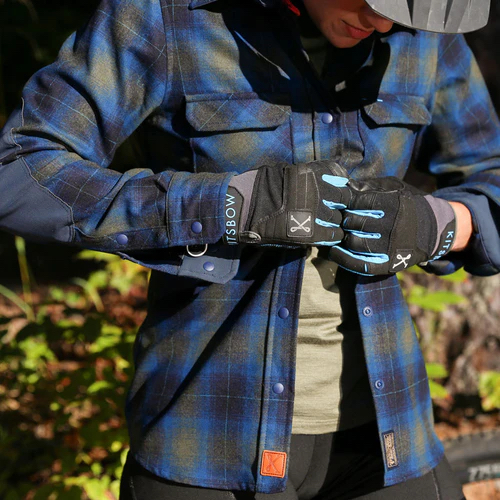If you’re in the UK, there’s every chance you’ve never heard of Kitsbow, so why should you care that they’re closing? And who even are they?
Kitsbow were (or, until 7th April, are) USA based makers of cycling clothing. With an RRP of $289 – about £235 – for their ‘Icon’ flannel shirt, you might well put them in the category of ‘How Much?!’ and move along. However, they were trying to do things differently – sustainably, and at a living wage. There are parallels between what they were trying to do with clothing, and what Dan Stanton aimed to do with Stanton Bikes.

Kitsbow had moved its operations to a town on the slide in North Carolina. Moving there, it created manufacturing jobs, and even bike trails, and began to rebuild the community. People set up other businesses in the town, and even moved there. It seemed like it was offering the town some green shoots of economic regeneration.
The company had previously had some garments made abroad, but since early 2022, when Kitsbow became an employee owned venture, everything was made in Old Fort, North Carolina. They used lean manufacturing methods to streamline the process – moving towards making what was needed as customers ordered them, rather than guesstimating size and colour demands and having stock shipped half way round the world before sitting on the shelves. They were charging what they thought product should cost if you’re making it out of environmentally conscious sourcing of materials, and paying the people that make them a living wage.
In an extensive explanation of where things went wrong for them, it’s clear that the lack of appetite for the investment needed to establish these ways of working is what’s got them unstuck. Another parallel with Stanton Bikes – the withdrawal of an investor is what kicked off the administration process there.
Were Kitsbow’s ambitions just too grand? They say that they were operating as small a business as possible:
Some have asked if we could survive for another day as a smaller company – we considered this, but couldn’t survive without enough highly-skilled Cutters and Makers, customer service, and marketing personnel. Our work takes a minimum of our current staffing. We’re at our minimum point (about 40 full-time employees).
Kitsbow

In the grand scale of job loss announcements, 40 employees doesn’t sound like a lot. But the census says that in 2020, Old Fort only had a population of 811 – and that was after Kitsbow had moved there in 2019. Perhaps the new trails and the vibe that’s taken newcomers there will be enough to keep the town on an upwards trajectory. Perhaps it won’t. You’ve got to hope, because the other option is pretty depressing.
Why should you care, reading this, probably thousands of miles away from a small town in North Carolina that you’ll never visit, about a shirt you quite probably couldn’t afford?
I think you should care, because the other option is to continue as we are. Whether it’s exploiting the earth and using unsustainable resources, or it’s exploiting poor living conditions and deriving profit from low wages, the model of ‘make everything far away and ship it to the customers’ seems doomed to fail, eventually. Whether it’s the environmental cost of shipping things across the world, supply chain disruption from geo-political events, or just the loss of profit margin as wages rise in developing countries, something will surely catch up with the current model of manufacturing.
We might blame customers for taking the cheap option – for looking at the price tag while ignoring the cost. But if they’re trapped within an economy that’s not paying them a living wage, that seems a little unfair. Should we blame the investors who aren’t prepared to support businesses playing a long game of sustainable profits?
I don’t have the answers, but I can’t help but wonder ‘How Much?!’ do we have to lose before anything changes?





